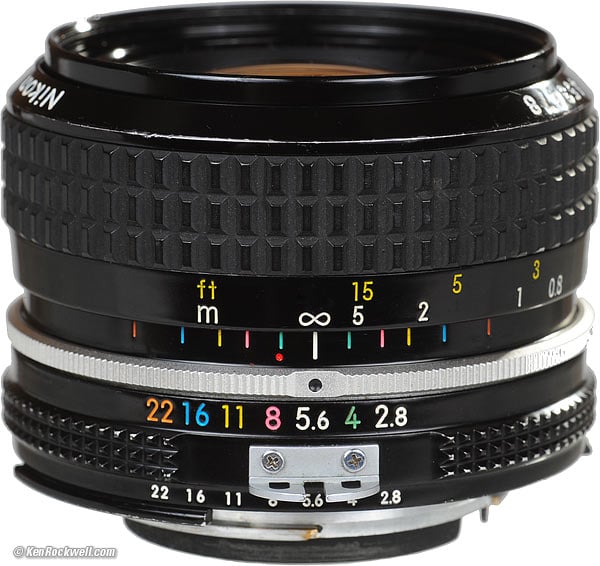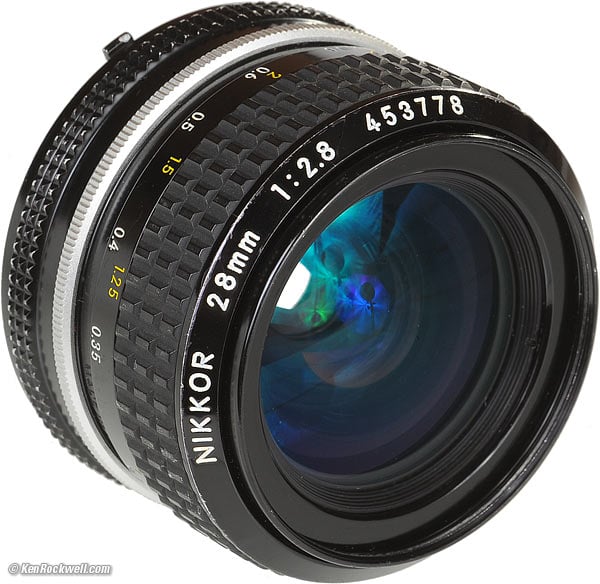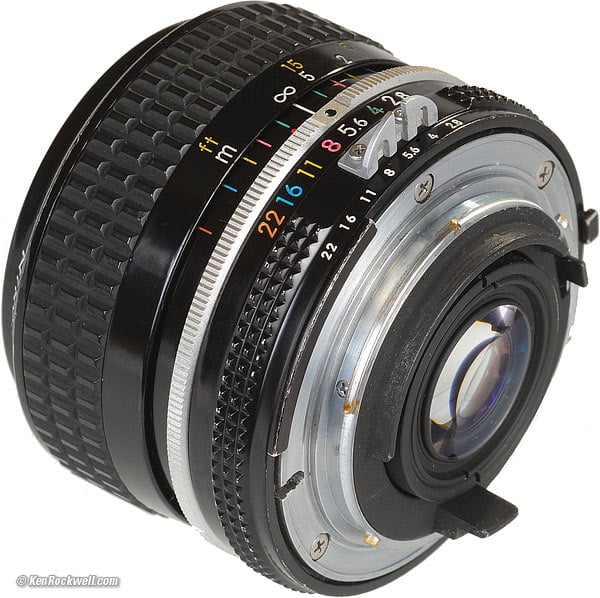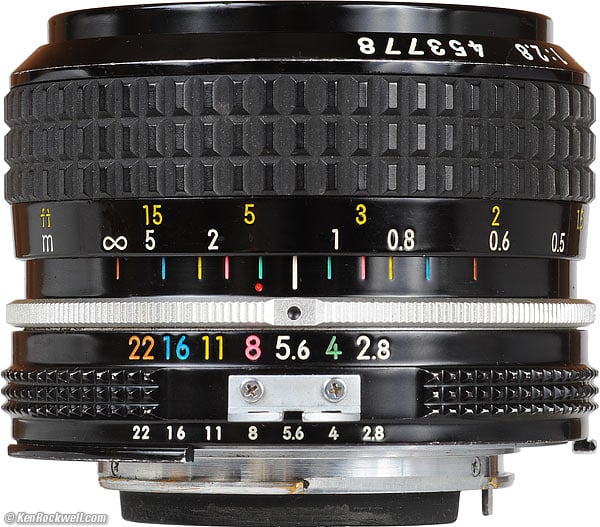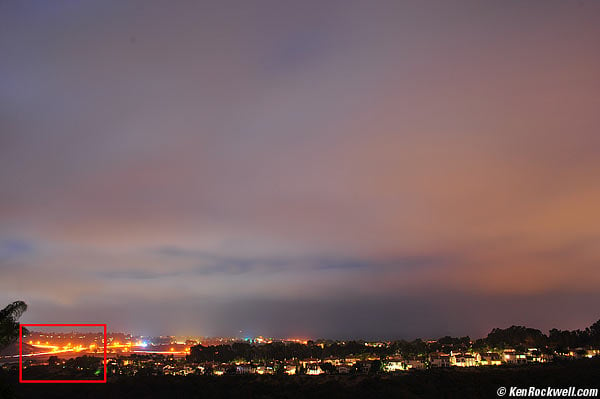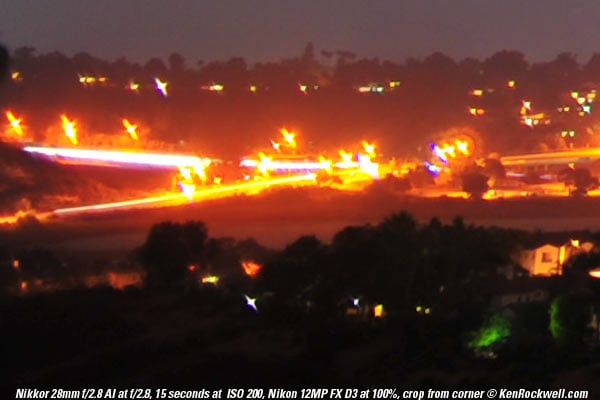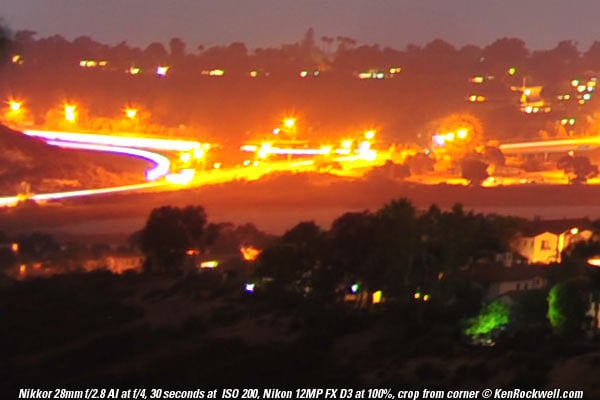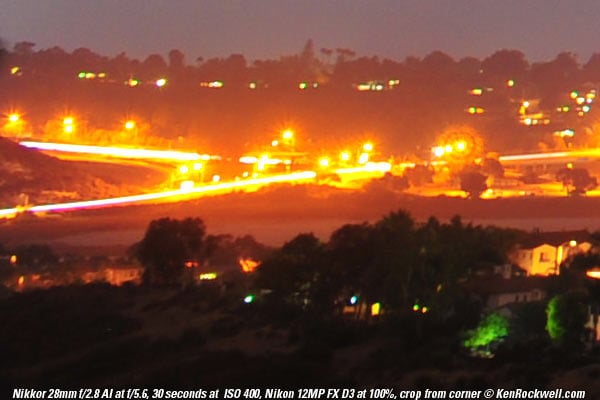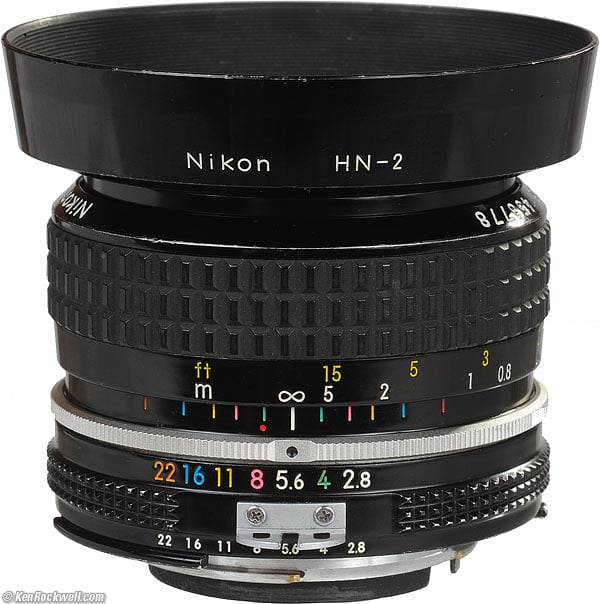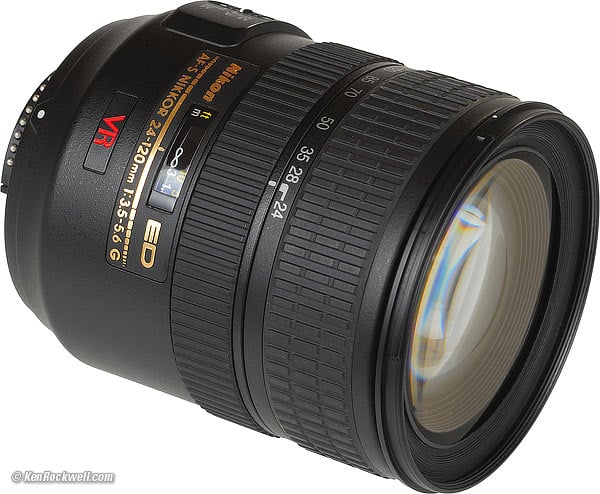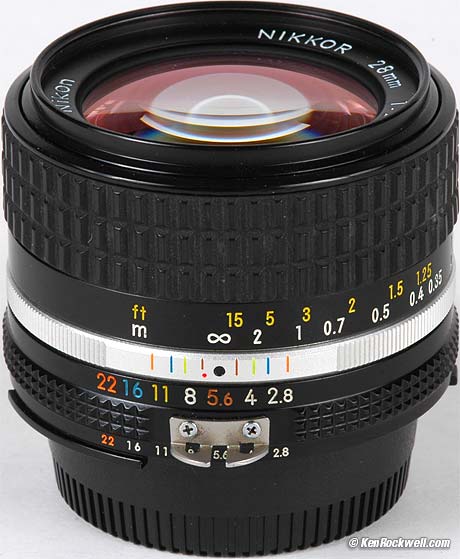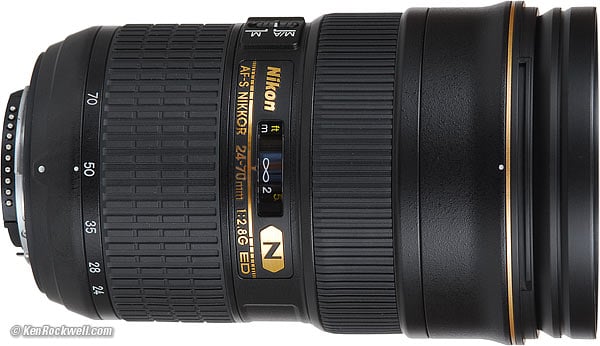Home New Search Gallery How-To Books Links Workshops About Contact
Nikon 28mm f/2.8 AI Nikon 28mm f/2.8 AI (52mm metal filter threads, 8.5 oz./241g, 1'/0.3m close focus, about $100 used) enlarge. I got mine from this direct link to them at eBay (see How to Win at eBay.
July 2014 Nikon Reviews Nikon Lenses All Reviews
Introduction top Intro Specifications Performance Recommendations Compatibility History Production Pricing Ideal Uses: Manual-focus, fast, general-purpose FX wide-angle lens. Especially sharp for tripod-huggers and to use on D3, D3x and D700. Not for: I wouldn't bother with this on a DX camera. I'd use a DX lens, like the 18-55mm kit lens, instead because it will autofocus.
This 7-element 28mm f/2.8 AI was Nikon's most popular wide angle lens from 1974-1981. It's sharp, fast and works great on film and FX cameras. Compared to iffy zooms like the 24-120mm VR, this old lens has far superior optics, and is a stop faster. Nikon 28mm f/2.8 AI. enlarge.
Compatibility back to intro back to top The manual-focus 28mm f/2.8 AI works great with most Nikon cameras, film and digital. It works flawlessly with every manual focus Nikon ever made, from the F of 1959 through the FM3a and today's FM-10. On the D3, D700, D300, D200, D2 and F6, use the "Non-CPU Lens Data" menu option to set 28mm and f/2.8 to get full matrix metering, EXIF data and finder read-out of set aperture. It works great in aperture-preferred as well as manual modes on these cameras. The meters of cheaper digital (D80 and below) and cheaper film cameras (N80 and below) will not couple (or work at all) with this lens, so you'll be on your own guessing exposure using the rear LCD or an external meter. It works perfectly every professional film camera (F, F2, F3, F4, F5, F6), and adds Matrix metering on the FA, F4 and F6. See Nikon Lens Compatibility for details on your camera. Read down the "AI, AI-s" column for this lens.
28mm History back to intro back to top 1960-1986: Nikon's first 28mm SLR lens was the 28mm f/3.5. It had 6 elements in 6 groups. Nikon redesigned its optics in 1977. It came in all flavors from non-AI through AI-s. Many of the older 1960-1977 lenses have been updated to AI for use on modern cameras. 1974-1977: Nikon introduced this faster 7-element lens in non-AI form. 1977-1981: Nikon updated this lens to AI, the version you see on this page. 1979-1985: Nikon made the crappier 5-element 28mm f/2.8 Series E. It is optically and mechanically inferior to the other manual focus 28mm lenses. 1981-present: Nikon replaced this excellent original 28mm f/2.8 with the spectacular AI-s version with 8 elements in 8 groups. The current AI-s lens also adds the Close Range Correction (CRC) system. 1986-1995: Nikon's first 28mm f/2.8 AF lens was optically the same as the 5 element Series E. 1994-present: Nikon's 28mm f/2.8 AF-D has 6 elements. I haven't tested it, but suspect it is excellent.
Nikon 28mm f/2.8 AI. enlarge.
Production back to intro back to top Nikon made about 40,000 of the optically identical non-AI version 28mm f/2.8, and about 200,000 of the AI version seen here. Nikon has made about 750,000 of all the various f/3.5 versions. Nikon made about 250,000 Series E 28mm lenses. To date, Nikon has made about 225,000 of the AI-s lens, and is still making them in 2008.
Pricing back to intro back to top
* At full NYC discount. Very few people bought their lenses this inexpensively back then. ** For the even better 28mm f/2.8 AI-s. ** At a dealer. At a garage sale, these go for $15.
Specifications with commentary top Intro Specifications Performance Recommendations
Nikon 28mm f/2.8 AI Schematic Diagram. Optics 7 elements in 7 groups. Nikon Integrated multicoating (NIC). Conventional design, no CRC.
Marked Focal Length 28mm. If you're picky, its focal length is just a little bit shorter then the newer 28mm f/2.8 AI-s.
Close Focus 1 foot (0.3m).
Maximum Reproduction Ratio 1:7.5.
Hard Infinity Focus Stop? Yes. This is great for astronomy; just turn to the stop and you have fixed laboratory-perfect focus all night.
Depth-of-Field Scale Yes.
Infra-Red Focus Index Yes, red dot near f/4 on depth-of-field scale.
Diaphragm 7 straight blades. Stops down to f/22.
Aperture Ring Yes, full-stop clicks.
Filter Thread 52mm, metal. Does not rotate.
Size Nikon specifies 1.75" (44.5mm) extension from flange (2.15" [54.5mm] overall) by 2.50" (63.5mm) diameter.
Weight 8.515 oz. (241.4g), measured. Nikon specifies 8.7 oz. (245g).
Hood HN-2 metal screw-in. More at Hoods below.
Case Depending on the source, any of the CL-30, CL-31, pouch #54 or #61 or the plastic bubble case CP-1 works fine.
Teleconverters TC-200/201 and TC-14A.
Performance top Intro Specifications Performance Recommendations Overall Focus Color Coma Distortion Falloff Filters Ghosts Hood Color Fringes Mechanics Sharpness Sunstars Comparisons Nikon 28mm f/2.8 AI. enlarge. Overall back to Performance back to top The 28mm f/2.8 AI is a sharp, fast, contrasty and easy-to-use lens. You won't appreciate its image quality and mechanical precision until you use one for yourself.
Focus back to Performance back to top Manual focus is a dream. Nikon's trademark, all it takes is one fingertip to focus. It has no play, it's as smooth as silk, and slides fast since it's not gummed-up with grease that third party lenses use to hide their sloppy workmanship. Its fast f/2.8 aperture makes it sharp and bright with manual focus cameras. The D3, D700, F4, F6 and most professional AF cameras have three very precise electronic manual focus indicators. Lesser digital cameras, like the D300 and down, usually have just one "OK" focus dot, which is not as precise as two arrows and a dot.
Color Rendition back to Performance back to top The color rendition is a little more red-magenta than my 28mm f/2.8 AI-s and 24-70 AFS. This makes sense, since the multi coatings look predominantly green-cyan.
Coma back to Performance back to top Coma is when bright points of light in the corners turn into blobs. These happen with fast and wide lenses at large apertures. Coma goes away as stopped down, and tends not to be seen in slower and tele lenses. Coma is an artifact of spherical aberration, and is one of the things that's often cleared-up when a lens uses aspherical elements. The 28 2.8 AI has just a little bit of coma wide-open in the corners of the full FX frame. It won't have any on DX cameras, since their corners are still in the middle of the FX frame (see crop factor). Here are examples on FX. Please note that a complete print at the same magnification as the cropped images will be 42" (1.1m) wide!
Full-Frame FX Guide Image. Crops are the red box on lower left.
At f/2.8.
At f/4.
At f/5.6. This is great performance. Other lenses, especially those nasty third-party 28 f/2.8s, look much worse.
Distortion back to performance back to top The 28mm f/2.8 AI has no visible distortion at normal distances. It has a bit of barrel (bulging) distortion jammed in your face at one foot (30cm). It can be eliminated by plugging these figures into Photoshop CS2's lens distortion filter. These aren't facts or specifications, they are the results of my research that requires hours of photography and calculations on the resulting data.
© 2008 KenRockwell.com. All rights reserved. * A couple of pixels of waviness remain.
Falloff (darkened corners) back to performance back to top Falloff, for real photographs on FX, is minimal at f/2.8 and invisible otherwise. I've exaggerated this by shooting a gray field and placing these on a gray background.
There is a slight cooling of color balance in the corners on FX. This comes from the effects of the coatings when light hits them at different angles. The coatings' most effective wavelengths change with the angle of incidence.
Filters, Use with back to Performance back to top There is no vignetting with normal and rotating filters up to about 7mm thickness. Be careful with stacked filters on FX, or you will get vignetting. There's never a problem on DX.
Ghosts back to Performance back to top There aren't much in the way of ghosts. To wake up any ghosts, you need to have the disk of the mid-day sun in the image and overexpose enough to see into large shadows. If you do this, you'll see some big green disks wide open, and smaller, brighter ones stopped-down. I can't see any ghosts where it's important, which are in night photos with bright city lights in them.
HN-2 Hood back to Performance back to top
Nikon 28mm f/2.8 with HN-2 Hood. enlarge. The 28mm f/2.8 uses the HN-2 screw-in metal hood. I have no problems with flare or ghosts, but these hoods are small enough to leave on the lens all the time. Use a modern Nikon 52mm "pinch" front cap, and you can cap and uncap the lens with the hood attached. Hint: The front of the HN-2 accepts 72mm snap-in (not screw-in) caps, which are even easier to attach and remove than reaching in for a 52mm cap.
Lateral Color Fringes back to Performance back to top There can be very minor amber/blue lateral color fringes when used on the D3. I only see them if I look for them deliberately. Most of the time the D3 corrects these, so there aren't any.
Mechanics back to Performance back to top Like all Nikkor manual focus AI lenses, the Nikon 28mm f/2.8 AI is built to the highest mechanical standards of any lens ever made. Barrel Exterior: Anodized and enameled aluminum. Filter Threads: Anodized aluminum. HN-2 Hood: Threaded anodized aluminum (optional). Focus Ring: Metal, rubber covered. Focus Helicoids: Feels like brass: smooth and silky with no play or need for damping grease. Depth-of-Field Scale: Engraved into barrel and filled with different colors of paint. Internals: Metal. Aperture Ring: Cast aluminum, anodized and enameled. Engraved markings filled with different colors of paint coded to the depth-of-field scale. Mount: Dull-chromed brass. Markings: Engraved into the metal and filled with paint. Identity and Serial Number: On the front of the focus ring, engraved into the metal and filled with paint. Oddly, both samples I've seen look like an identity ring fell off the inside of the filter ring. There is a shiny black, blank, flat ring between the glass and filter threads. Not to worry, this is the way the lens is supposed to be. Ass-Gasket (dust seal at mount): No. Noises When Shaken: Mild clicking from the diaphragm blades and actuation system. Made in: Japan.
Sharpness back to Performance back to top Warning 1: Image sharpness depends more on you than on your lens. Warning 2: Lens sharpness doesn't mean much to good photographers. With these caveats, the 28mm f/2.8 AI almost always gives sharp, colorful, contrasty results at every aperture. Unlike many lenses, it's hard to make an unsharp image with this lens. I like this lens for exactly this reason: Regardless of the aperture, images are super-sharp.
Shot on a 12 MP FX Camera at 100% (a 40" [1m] wide print): At f/2.8: It's sharp and contrasty all over, even in the far corners. The last 2 millimeters of the far corners are less sharp than the center. At f/4: The far corners are better. The rest of the image was already excellent at f/2.8, and now even a little sharper. At f/5.6: The far corners are sharp, too. At f/8: The far corners are as sharp as the center. f/8 is the optimum aperture. Actually, f/5.6 is 99% as good, and wide-open is as good if you ignore the last 2mm of the far corners of FX At f/11: Same as f/8. At f/16 and f/22: Diffraction limits performance.
Sunstars back to Performance back to top With its straight 7-bladed diaphragm, the 28/2.8 AI makes Nikon-standard 14-pointed sunstars on bright points of light.
back to Performance back to top The old 28mm f/2.8 AI looks far better than the crummy 24-120 VR. It looks almost identical to the Nikon 28mm f/2.8 AI-s and 24-70mm f/2.8 AF-S. If I hadn't been making direct comparisons, I doubt I I could have told which was which.
Compared to the Nikon 24-120mm VR Optically, the old 28mm f/2.8 AI lens makes the new 24-120 VR look like a toy. This old lens is much, much sharper, probably enough to be visible on the sides of even reasonably-sized prints from FX or film. Of course the VR lens autofocuses with modern cameras and has vibration reduction for hand-holding in dim light, but the AI lens is almost a stop faster anyway. The old AI lens looks great wide-open at f/2.8, while the new VR lens looks awful at 28mm wide-open. The VR lens is loaded with distortion at 28mm, while the old AI lens has no visible distortion.
Compared to the 28mm f/2.8 AI-s (still available new) The older AI lens has a slightly shorter actual focal length, at infinity. Its focus is geared faster than the AI version. The older AI lens is slightly less sharp at f/2.8 for astronomy, and, on a D3, very, very slightly less sharp overall. I'd never see this difference if I hadn't shot the same landscapes at infinity and compared them by switching between images on the same screen; I'd never see this in stand-alone shots, or even in two huge prints side-by-side. The older lens has slightly less falloff at f/2.8, but is slightly sharper in the corners at f/2.8. The old lens doesn't focus as close. The old lens is slightly more red-magenta than the 28mm f/2.8 AI-s. The newer AI-s lens is superior, but only slightly so.
Compared to the 24-70mm f/2.8 AF-S at 28mm The two are about as sharp at f/2.8, everywhere in the frame. This old lens might even be a hair sharper in the corners wide-open. At f/4 and smaller, the 24-70mm AF-s is a little sharper. The zoom has less falloff wide-open. The zoom has four times more distortion. The zoom has quite visible distortion of straight lines at 28mm, while neither of the AI-s or AI 28mm f/2.8 lenses have any visible distortion The 28mm AI is slightly more red-magenta than the 24-70mm AF-s.
Recommendations top Intro Specifications Performance Recommendations Want one of the sharpest 28mm lenses ever made for your film or FX camera? Want one of Nikon's least expensive lenses available used? Don't mid focusing by hand? Get one of these. The newer 28mm f/2.8 AI-s is even better, and is still available new, but there is little to no real difference between these 28mm lenses on a D3. On a D3x, it probably will make a difference. For FX digital and AF film cameras, most people will prefer the convenience of autofocus in the current Nikon 28mm f/2.8 D AF. For DX cameras, forget this lens and use even the 18-55mm kit lens. It's just as sharp, and far more convenient. Deployment I'd leave either a 52mm Nikon Clear (NC - UV) filter, or a 52mm Hoya Super HMC UV on the lens at all times. Use the HN-2 hood if you like, or not; it's no big deal. I'd pitch the flat Nikon cap that came with this lens new, and get a new 52mm "pinch" type cap . The new fatter caps are much easier to use in the field, and if you use a hood, can be put on and off without having to touch the hood.
Help me help you top I support my growing family through this website, as crazy as it might seem. The biggest help is when you use any of these links when you get anything, regardless of the country in which you live. It costs you nothing, and is this site's, and thus my family's, biggest source of support. These places have the best prices and service, which is why I've used them since before this website existed. I recommend them all personally. If you find this page as helpful as a book you might have had to buy or a workshop you may have had to take, feel free to help me continue helping everyone. If you've gotten your gear through one of my links or helped otherwise, you're family. It's great people like you who allow me to keep adding to this site full-time. Thanks! If you haven't helped yet, please do, and consider helping me with a gift of $5.00. As this page is copyrighted and formally registered, it is unlawful to make copies, especially in the form of printouts for personal use. If you wish to make a printout for personal use, you are granted one-time permission only if you PayPal me $5.00 per printout or part thereof. Thank you!
Thanks for reading!
Mr. & Mrs. Ken Rockwell, Ryan and Katie.
Home Donate New Search Gallery Reviews How-To Books Links Workshops About Contact
|
Juily 2008

